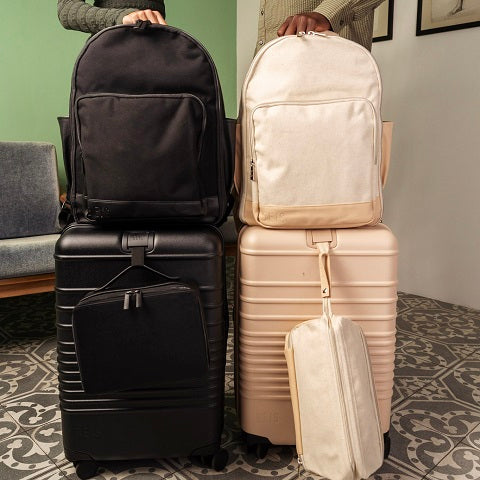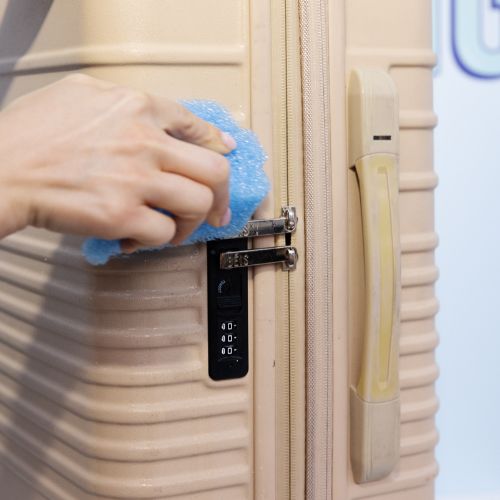Whether you’re spending the holidays at your parents’ home, taking a girls’ weekend in Miami, or taking off for a city getaway in Amsterdam, all of these trips have a very different packing list. So when choosing a vessel, which luggage size works best for each?
If you’re at home procrastinating on packing, we can help. Our luggage size guide will break down the dimensions, differences, and dos and don’ts of each suitcase size. No matter your trip, there’s a bag to fit.
What Are the Standard Sizes for Luggage?
Even if you’re traveling by car or train, your luggage options are probably limited to airline size standards. Why? Airplanes have very specific luggage weight and dimension requirements for all baggage items. Carry-on luggage and hand luggage must fit within the cabin, while check in luggage must stay underweight. To be sure your luggage collection fits the bill for just about any trip, stick with flight-approved sizes.
Almost all standard types of luggage sizes can be broken down into three categories:
- Hand baggage (or personal items) – Small bags to stow underneath the airplane seat in front of you.
- Carry-on luggage – Medium-sized bags to fit in the overhead compartment of airplane cabins.
- Checked luggage – Large bags checked prior to your flight for stowing in the airplane’s cargo compartment.
Every airline has its own size standards for each category. However, they mostly hover around the same dimensions. If you’re aiming to be a savvy traveler, it’s best to own at least one of each category. That way, you’ll be able to pack like a pro for any trip.
Hand Luggage or Personal Items
Work briefcases, travel backpacks, your fave crossbody satchel—all count as personal items, or hand baggage, when traveling.
Hand luggage is like a cross between a purse and a suitcase. It’s meant to hold all of the must-have items on your journey, from phones to chapstick. Most importantly, handbags have to fit under airplane seats to travel above ground with you.
Looking for your next all-purpose purse to bring onboard? Let’s discuss which size, design, and other bag characteristics to seek out so that you make the best decision, especially if you are between a carry-on vs personal item bag.
Size Standards
If bringing a tiny purse aboard, then you don’t have to worry about size limits. But if you want to maximize packing space, then you should know the typical dimensions for hand luggage.
On most domestic flights, personal items can range anywhere from 17x10x9 inches to 18x14x8 inches. While you might be able to get away with stuffing a larger backpack underneath, it’s best to stick within this size range. Opt for a large purse, mini duffel, or zippered tote like our East to West Tote—it packs a sturdy design and style into one compact bag.
Hand Luggage & Personal Item Examples
This isn’t your daintiest designer clutch. A personal item is meant to withstand travel. That includes all bags or cases that protect and hold space for your belongings, such as:
- Larger purses
- Satchels
- Laptop bags
- Briefcases
- Small backpacks
- Mini totes or duffels
Remember—the term “personal item” has a wide definition on airplanes. Your umbrella, coat, or any furry companion might even be considered a personal item. Just make sure your hand luggage plans account for the airline’s specific policies.
Uses and Benefits
Sure, you could forgo a personal item onboard or on-the-road. But these bags almost always come in handy. Consider traveling with your favorite tote in tow for these benefits:
- On-hand items – On flights or road trips, everyone needs their essentials (phone, earbuds, chocolate-covered pretzels, etc). A roomy handbag keeps those items within reach. If your trip is any longer than one hour, it’s a must-have bag.
- Valuables protection – Sometimes, you don’t want to risk a lost-and-found scenario. For those precious valuables, stash them in your hand luggage. They’ll stay right by your side (and in your sight) the whole trip.
- Free space – Who would give up free cargo space? When flying on a budget, every inch counts. Make the difference between an approved carry-on and an overweight fee with your hand luggage. That extra space could end up saving you money and peace of mind.

Carry-On Luggage
Not too big, not too small—out of all the different luggage sizes, carry-on bags are your happy medium.
Carry-on luggage, or cabin luggage, is just spacious enough for that weekend beach getaway or midweek business trip—no checked bags necessary. If traveling long-term, they provide sufficient (and sometimes free) packing space onboard. Combine with a checked bag, and you’ll be set for any continental tour.
All travelers need a carry-on bag. But when’s the best time to use it? And how many outfits can it take? Let’s unpack the ins and outs of this mid-size cabin luggage.
[[the-carry-on-roller-in-black]]
Size Standards
Like with hand luggage, airlines also maintain standard sizing rules for carry-on bags. The result? Plenty of mid-size suitcase options that should occupy relatively similar dimensions.
Although it would certainly make our lives easier, there is no universal standard suitcase size for cabin baggage. Each airline has its own specific measurements, ranging around 22x14x9 inches to 24x16x10 inches.2 Maximize your bag’s use across a variety of airlines by leaning on the smaller side. That way, you’ll never worry about it fitting into an overhead bin or getting stopped at the check-in gate.
Carry-On Examples
From duffels to hiking packs, a carry-on bag should fit inside a plane’s cabin space easily, whether it be in an overhead bin or under-seat area. That means staying away from bags that have zero structure or zip sliders—you don’t want any items to spill out or squish while flying.
To maximize space while staying within size limits, look for these common carry-on bags:
- Duffels
- Roller suitcases
- Larger backpacks
- Roller backpacks
- Zippered totes
Uses and Benefits
Versatility is the name of your cabin luggage’s game. On flights, your carry-on baggage can offer zero baggage fees, extra packing space, and accessibility to your belongings. Consider packing cabin luggage on your next trip for these benefits:
- Lightweight luggage for short trips – Planning a long weekend nature retreat? How about a quick Thanksgiving trip back home? A carry-on bag is the perfect vessel. There’s just enough room for a weekend’s worth of outfits and all your necessities.
- No checked baggage – Sure, checking your bags means zero lifting and hauling onboard. But with checked bags always comes the dreaded baggage carousel. A small bag that you can carry-on helps you avoid the hassle of running to the carousel post-flight—or even worse, discovering your checked bag is MIA.
- Free packing space – If your ticket qualifies for a carry-on bag, that’s free cargo space! Unless you absolutely need a checked bag, take advantage of that packing room. Even if you have to pay a carry-on fee, you’ll save at least a few dollars over checking your bag.
- Backup items – Once onboard, it’s all a guessing game. You might get sweaty, cold, thirsty, hungry—who knows?! When your personal item can’t hold everything, a carry-on has your back. Keep that cozy cardigan or eye mask close by packing them in your cabin luggage.

Checked Luggage
Finally taking that dream, month-long vacation in little ol’ Paris? Then you’ll need more than three to four outfits. That’s where your checked luggage bag comes in.
[[the-26-check-in-roller-in-black]]
Sizing
Checked bag sizes are more about minimums than maximums. Once a suitcase outgrows cabin luggage dimensions (around 24x16x10 inches), then it’s considered checked luggage.
So how large can a checked bag be? For some airlines, the sky’s the limit. Others might pass a maximum length of 62 inches. While there are no standard suitcase dimensions for checked bags across the board, here are a few typical sizes and their packing capacities:
- Small checked bag – 24x17x10.5 inches; ideal for 4 to 7-day trips
- Medium checked bag – 27x18.5x14 inches; ideal for 7 to 10-day trips
- Large checked bag – 32x22x14x inches; ideal for 7 to 14-day trips
Keep in mind that most airlines have a weight limit for checked bags—usually around 50 to 70 pounds.3 When packing your largest roller, start with your heaviest items and build from there.
Checked Luggage Examples
With larger luggage, you need functional designs that prioritize organization and mobility. Otherwise, you might find yourself dragging your suitcase across the airport floor. For checked luggage, look for suitcases and travel bags with some of these features:
- Roller wheels
- Wide shoulder straps
- Outer zipper compartments
- Inner mesh compartments (for delicate belongings)
- Durable yet lightweight materials (plastic, polyester canvas, etc.)
Uses and Benefits
The main reason for checked luggage? Space, space, and more space.
Whether you’re driving, flying, or catching a train, a checked suitcase offers the most room for the least amount of bags. However, to maximize space even in a larger bag, you’ll want to learn how to pack a suitcase efficiently. Lengthy trips often need that extra packing room (or you might wind up washing your clothes in the hotel sink). Plus, for those who hate feeling weighed down when traveling, a checked bag keeps your hands free from hassle—no need to haul and lift your suitcase across the airport.
[[the-29-large-check-in-roller-in-black]]
Size Up Your Travel With BEIS
Whether you’re off on a weekend getaway or month-long sabbatical, the right size suitcase can make all the difference. Make travel a breeze by keeping a few different sizes on hand. From tiny satchels to roller duffels, every suitcase has its destination.
Want luggage that’s just as trendy as it is practical? With BÉIS, you’ll never have to sacrifice style for smart packing. Our luggage sends you out on the open road while looking your best, with designs like monochrome plastic encasements to sleek black luggage and vegan leather straps. Lift, roll, and carry in fashion with BÉIS suitcases and bags.
Sources:
- Ditaranto, Jamie. “Carry-on and Personal Item Size Limits for 32 Major Airlines.” SmarterTravel, 27 July 2020, www.smartertravel.com/personal-item-vs-carry-on
- Miller, Alex. “Carry-On Luggage Size Chart for 58 Major Airlines [Dimensions, Sizes & More].” UpgradedPoints.Com, 4 June 2021, upgradedpoints.com/travel/airlines/carry-on-luggage-size-chart
- Chua, Alyssa. “What’s the Largest Size for Checked Luggage – 29 or 32 In?” Clever Journey | Travel Gear Reviews, Packing Tips, Travel Advice, 11 Nov. 2021, www.cleverjourney.com/largest-size-checked-luggage
-
Eagleman, James. “Standard Luggage Sizes? – A Guide To Typical Suitcase Dimensions & Average Measurements.” Traveling Light, 25 Feb. 2021, travelinglight.com/standard-luggage-size













